Conserving energy and reducing environmental impacts have been major considerations in designing and constructing new buildings. Now, a new trend for built environments is emerging, particularly when it comes to office space – designing for human wellness.
This effort is being championed by Delos, which pioneered the WELL Building Standard. Much like the LEED (Leadership in Energy and Environmental Design) Standard ranks projects based on their environmental friendliness and energy-efficiency, the WELL Building Standard ranks built environments on seven concepts affecting human wellness: air, water, light, nourishment, fitness, comfort and mind.
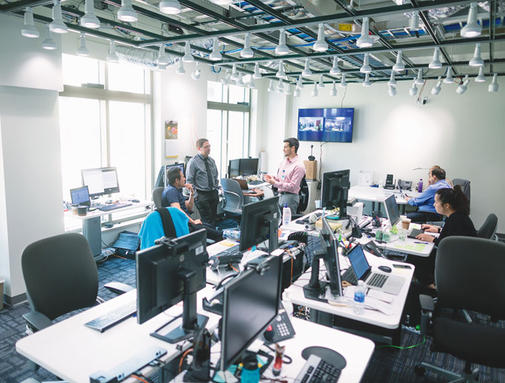
The Well Living Lab is a high-tech facility outfitted with technology that allows researchers to change environmental stimuli like light, temperature and sound – as well as floor plan configuration – in an effort to identify how office workers’ environments affect them. The lab is a partnership between Delos and the Mayo Clinic. (Photograph provided by the Well Living Lab)
The company’s website notes that people spend 90% of their time indoors. Our indoor, built environments thus “have a profound effect on our well-being.”
Delos takes this concept so seriously that it has heavily invested in a futuristic laboratory called the Well Living Lab in Rochester, Minnesota, adjacent to the Mayo Clinic’s headquarters. The Mayo Clinic is a nonprofit medical practice, hospital and research group that dates back more than 150 years. It is consistently ranked as one of the nation’s best hospitals and is well known for pioneering medical research studies.
The Well Living Lab is a high-tech, 5,500-square-foot space in an office building dubbed the Bio Business Center. Its purpose is to generate research that engenders a deeper understanding of the connection between indoor environments and health.
The lab is reconfigurable into a variety of office layouts and floor plans meant to mimic home environments. This enables researchers to measure how an array of environments could impact health – and what elements of those environments may be better, or worse, for us.
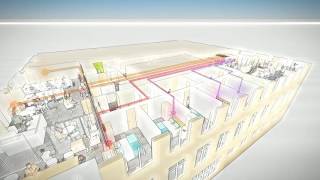
A virtual tour of the Well Living Lab.
The Well Living Lab is outfitted with sensors that measure the quality of the space and changes in the environment, windows specially equipped to control how much natural light is entering, and full-spectrum LED lighting. Human test subjects wear biometric devices to collect data and feedback on how their environment is affecting them.
The lab’s reconfigurable ceiling system allows researchers to alter lighting, ventilation and more. Removable floor tiles allow redirection of electricity, plumbing and other infrastructure to allow easy reconfiguration of spaces.
The lab opened in May 2016 and began its first experiment to determine how an office environment affected the health of the workers within it. Specifically, the experiment examined how acoustics, lighting and thermo conditions impact workers, according to Barbara Spurrier, the lab’s administrative director.
Test subjects temporarily relocated from their actual offices into the lab, which was configured to mimic their environment, according to Spurrier. The results of the experiment are soon to be released.
Future experiments will focus on how employee performance and productivity are affected by their environments, according to Spurrier.
Chip Israel, CEO and founder of Long Beach-based Lighting Design Alliance, said designing for wellness is a trend impacting all aspects of the lighting industry. A sampling of projects from LDA’s resume include Disney’s Aulani resort in Hawaii, The Venetian in Las Vegas, Cedars-Sinai Hospital, Disney’s offices in Burbank, and lighting fixtures on the Vincent Thomas Bridge crossing the San Pedro Bay harbor.
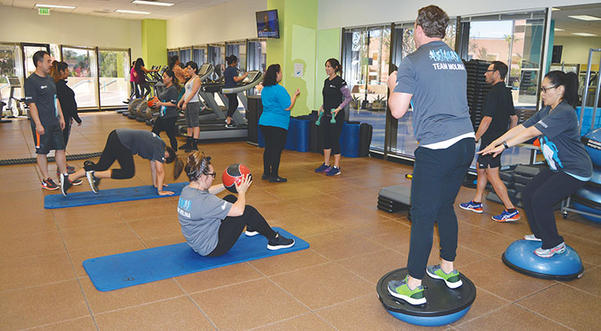
Led by staff from Executive Fitness, Molina Healthcare employees take a break from work to exercise at their onsite gym. (Photograph by the Business Journal’s Larry Duncan)
“Historically, we were always worried about how much light falls onto the desk,” Israel said. The discovery of light-related wellness problems like seasonal affective disorder – depression related to limited exposure to sunlight – caused a reassessment of this ideology to consider how much light should be hitting one’s face, according to Israel.
Starting in the 1950s, windows came to be considered energy-inefficient because they easily let heat in or out of buildings, according to Israel. So, fluorescent lights were invented and windows in offices became smaller.
“We’re finding out maybe we need a lot more light in these spaces. But it’s kind of contradictory to our energy codes because they keep saying put in less and less electric light because we don’t want to build new power plants,” Israel said.
“There is a lot of talk about using LEDs that are now available. And you can mix the colors, and you can replicate daylight,” Israel said. “Which makes sense, because if you think about it, for tens of thousands of years we’ve pretty much lived outside.”
Many of LDA’s designs incorporate natural light. “My whole point is, why don’t we just put in a window, put in a skylight? You know, let’s do it using natural sources whenever possible,” Israel said. Using natural lighting also saves energy, he noted.
LDA’s own office has a variety of natural lighting solutions, including solar tubes and skylights equipped with light diffusers and mirrors to reflect light as the sun moves.
“Anything that we can do to perhaps reduce sick days . . . [and] to create a better environment for the people, that’s really why we want to do this,” Israel said. “And if we can make somebody 5% more productive, it pays for all of the lighting costs.” He added, “Happier employees should make a more efficient company, plus you save energy. That’s a win for everybody.”
Creating Cultures Of Wellness In The Workplace
In addition to designing workplaces for wellness, some companies are creating wellness programs and providing fitness equipment at worksites, and even offer healthy food and on-site medical services to employees.
Long Beach-based Executive Fitness has operated a corporate wellness program for five years. The 20-year-old Long Beach fitness firm is operated by husband and wife Lisa and Casey Kammel.
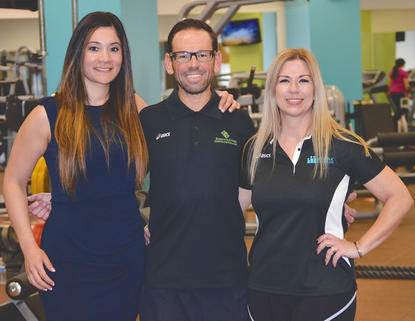
Long Beach-based Executive Fitness staffs and oversees fitness programs for Molina Healthcare. Pictured at Molina Healthcare’s onsite gym at Molina Towers are, from left, Executive Fitness Director of Operations Gema Barrios and co-owners Casey and Lisa Kammel. (Photograph by the Business Journal’s Larry Duncan)
“We started working with a local company and going into their offices and using conference rooms to teach group classes,” Lisa Kammel recalled. “So literally it would be moving furniture, bringing in equipment that would be things like medicine balls and stretching bands, and really opening the eyes of these employees to things they could do with very little resources,” she said.
Executive Fitness provides fitness services to Fortune 500 company Molina Healthcare. The fitness company manages an on-site gym at Molina Towers in Downtown Long Beach for Molina employees and three similar facilities at out-of-state offices. “That features group classrooms, a full gym with equipment with personal trainers on hand, and fitness professionals to run programming,” Kammel said. “And it’s a full facility exclusive to the employees of that company.”
Molina Healthcare has invested in these fitness facilities and programs to encourage employees to be active. “The real goal is to try to get those employees to step away from the desk for a little bit and really allow a clearing of the mind,” Kammel said. “And allowing your body to attain some of that little bit of a healthy break so you can be stronger and be more mentally focused.” She noted that Molina also has its own internal wellness program for employees in addition to the fitness services her company provides.
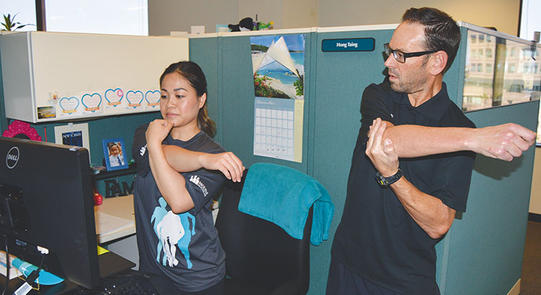
Executive Fitness co-owner Casey Kammel shows a Molina Healthcare employee how to stretch in place at her standing desk. (Photograph by the Business Journal’s Larry Duncan)
One of the most common causes of health issues among office employees is being sedentary, according to Kammel. “You know, unfortunately, they’re not necessarily getting up and taking breaks from their desk, and [they’re] spending too much time sitting,” she explained. “Posture is a big concern.”
Executive Fitness also works with other local small businesses, such as Dean Anthony Salon. “With respect to the people at Dean Anthony, those hairstylists are standing long hours on their feet,” she said. “So I am teaching them stretching, range of motion, how they can hold their posture a little bit differently, endurance and strengthening their upper body. They’re using those scissors all day long. We want those shoulders nice and strong.”
MemorialCare Health System is also focused on the health and wellness of its employees. “MemorialCare has been in the business of creating a culture of health and wellness overall for our employees for about 10 years,” Tammie Brailsford, COO and executive vice president of MemorialCare, said.
Brailsford said that the health system takes a “holistic approach” to employee health and wellness. “That takes the shape of being focused on many different things – physical activity being one of them, health and nutrition being another,” she said. MemorialCare also offers employees assistance in managing chronic illnesses or conditions and “financial and spiritual well-being,” she noted.
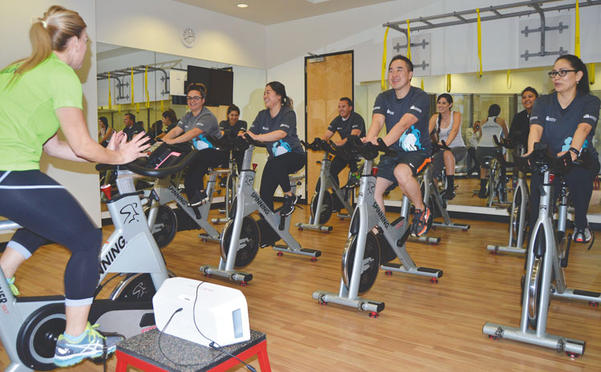
Molina Healthcare, a Fortune 500 company, provides an onsite gym at its Downtown Long Beach headquarters offices for exclusive use by its staff. The company encourages its employees to focus on their health and wellness both in and outside of the workplace. (Photograph by the Business Journal’s Larry Duncan)
“We have a gym on every campus and at our hospitals and at our corporate office. We provide yoga classes and the like at regular intervals throughout the day,” Brailsford said.
“We make standing desks and treadmill desks available for many of our employees,” Brailsford said. Treadmill desks are precisely what they sound like – desks affixed to treadmills so employees can walk and work at the same time.
The health system also makes a point to provide healthy food in its cafeterias. The healthiest food items are the cheapest, and the least nutritional are the most expensive in order to incentivize healthier eating, Brailsford noted. The organization’s Fountain Valley headquarters also features a health clinic staffed by a nurse practitioner, which has reduced time off taken for illness-related issues, according to Brailsford.
MemorialCare provides health coaches to employees with chronic conditions. “We have seen tremendous reduction in blood pressure and in hemoglobin A1c, which is an indicator of diabetes, [as well as] weight loss and overall improvement in health,” Brailsford said.
“We do an employee engagement survey every year with the help of the Gallup organization,” Brailsford said. “And a couple years ago we asked our employees whether our commitment to health and wellness and their well-being had helped them to live a healthier life. More than 86% of our employees responded affirmatively.”
